Hello, readers of the Fandomentals. Time for yet another trip down the memory lane with yours truly. This time, we’ll reminisce about the Heroes of Might & Magic series, which sadly looks to have been run into the ground by Ubisoft. But before we get to that depressing episode, let’s go all the way back to deep nineties…
Heroes of Might and Magic: A Strategic Quest
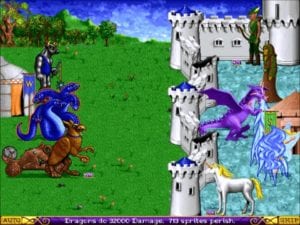
The first game in the series, but not the first one I’ve played. Let’s stick to the actual chronology, rather than my own, though. The first Heroes game was, as I understand it, something of an indirect sequel to the even older King’s Bounty game. I can’t say much about it, though, sadly, having never played it.
But from what I know, many elements of this ancient game made their way into Heroes. For one thing, the four factions, each with their own hero – Knights, Barbarians, Sorceresses and Warlocks. These are the eponymous heroes if might and magic. Might for the former two and magic for the latter, obviously.
Each faction has its own town, with six units going from weakest to strongest. Knights go from useless peasants through archers, pikemen, swordsmen, cavalry and paladins. Barbarians have goblins, orcs, wolves, ogres, trolls and cyclopes. Sorceresses use pixies, dwarves, elves, druids, unicorns and phoenixes. Warlocks field centaurs, gargoyles, griffins, minotaurs, hydras and dragons.
Of course, you’re hardly stuck with the faction you pick at the start. As you expand, you’ll conquer other cities and you’re free to use their units. However, units do get morale bonuses when their whole army consists of the same faction. Mixing more than two conversely results in morale penalties.
Factions aside, individual heroes play a central role. They lead armies, and you can’t field units without a hero. They gather experience and gain levels, which increases their attack, defence, spell power and knowledge attributes. The former two enhance the units under their command, while the latter two enhance spellcasting. The four classes have different affinities, but even might heroes will learn some magic to support their troops. To gain spells, you must build a mages’ guild in your towns, which contains a random set of them.
However, heroes do not take part in the battle. They cast spells and enhance their troops, but don’t fight. Once all the hero’s units die, they disappear. Sometimes they’ll resurface in a town where their former faction or another one can hire them. They can also flee, in which case their employer can rehire them immediately, or surrender, which costs money but retains their units and artifacts.
Heroes 1 set down what would become the core gameplay of the series. You expand from where you started, gathering resources and conquering new towns to build up your forces. Unlike in some other games, there’s no way to build more towns on your own. Resources consist of gold, ore, wood, sulfur, gems, crystals and mercury.
Unfortunately, the balance of play wasn’t so great. The knight faction was weak, while the warlocks dominated the game once they got their hands on dragons, their ultimate unit. The Knight’s peasant unit is, as I mentioned, worthless. It has the lowest stats possible and mostly wastes space in an army. It’s apparently a callback to King’s Bounty.
The plot of the game was fairly rudimentary. Four leaders, one for each faction, vied for power over the land. It’s all pretty simple, but it kicked off a massive series of games. Let’s see where it led to…
Heroes of Might and Magic 2: The Succession Wars
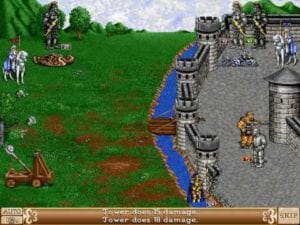
The first game of the series I played… one of the first games for me, period. It’s a very direct sequel, with four of the factions being implemented more or less directly and two new ones appearing. Those would be wizards and necromancers. The first faction has halflings, boars, golems, rocs, mages and giants. The second uses skeletons, zombies, mummies, vampires, liches and bone dragons.
The other four remain unchanged, but enriched. The sequel introduces upgrading units – after building the original dwelling we can upgrade it to provide us with a better version. It doesn’t apply to every dwelling – the knights can upgrade all their units except peasants, but other factions have four or three upgrades.
You’d really think they’d have made peasants less completely worthless this time around, but I guess a running gag is a running gag.
Heroes 2 doesn’t really take away or change anything the first game had. It adds things. New factions and unit upgrades are one thing, but another one was skills. Heroes can learn them when they level up – they range from wisdom to learn spells to leadership that increases unit morale or pathfinding that helps you cross difficult terrain. Much like spells in mages’ guilds, they are random, but different hero types have different affinities.
The balance remains wobbly. Dragons still dominate, but they’re now in competition with titans. They’re the wizards’ strongest units, once you upgrade them from giants. They don’t fly, but they throw thunderbolts at range, rivalling dragons in sheer power. Generally, the player who gets their hands on one or both of those units will have a major advantage.
The graphical style of the second game is much smoother, more realistic and less cartoony than the first one. The campaign followed that of Heroes 1, where the leader of the knight faction won… somehow. He had two sons, one of whom tried to usurp the throne from the other.
Heroes of Might and Magic 3
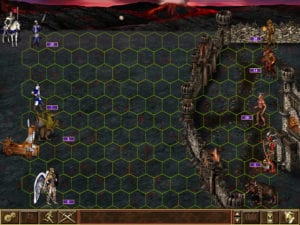
And now for the crown jewel of the series. This is the iconic part, that people still hold up today as the best. And… well. Normally I scoff at people holding on to an older part of the series as the Holy Grail, but in case of Heroes 3 it’s hard to argue. The game just distills the experience of Heroes into a solid, ever-lasting package.
Heroes 3 brings about much more significant changes to the game. It doesn’t use the exact same factions, replacing them with eight new ones… but you can clearly see elements of the old ones anyway. The factions are good, evil or neutral, but much like in Heroes 2 it mostly matters in the campaign. Which takes place in the same setting as Heroes 3, but a different land.
The Castle faction is the successor of Knights. The Rampart resembles Sorceresses, while the Tower inherits some of the Wizards’ roster, but with new additions. The Inferno is a new addition, while the Necropolis resembles Necromancers and the Dungeon incorporates elements of the Warlock. The Stronghold has several of the Barbarians’ units while the swampy Fortress is likewise new.
Each faction has seven units, rather than six, and each of them has an upgrade. The towns also have many more buildings available, unique to each faction. All of it contributes to a much greater variety and complexity.
The Might/Magic split now applies to every faction, which has two kinds of heroes. The Castle has Knights and Clerics. The Tower Alchemists and Wizards. And so on. Some factions still skew towards one or the other – for instance, the Stronghold and Fortress factions only have three levels of magic guild, where other factions have four or five.
The Castle, I should mention, no longer suffers from the dead weight of the peasant. Its replacement, the pikeman, is among the toughest tier 1 units. The crown of the weakest unit goes to imps from Inferno, but even they have their uses in sufficient numbers, unlike peasants.
The balance is still not perfect, but better than it was. Interestingly, where in the first two games damage-dealing magic was potent, in Heroes 3 it fails to scale properly and can’t keep up with tougher units. There’s a lot to write about the finer points of the balance and competitive play, but that would take a while and I don’t feel competent to do that.
Now, the expansion packs… here is where things get a little hairy. The first one, Armageddon’s Blade, introduces quite a lot of content. Whether or not it’s good is a matter of debate, except when it’s not. There’s a bit of a story behind it, as well. The expansion was originally going to introduce a new faction, the Forge. It would have had a strong sci-fi vibe, bringing the game closer to the plot and lore of the Might & Magic RPG series, which had always had those elements.
But it was not to be, as the fans reacted poorly. Many Heroes players had little to no idea about the lore of the RPG series and for them, the sci-fi elements were an intrusion with no place in their game. I was one of those people. I was young and stupid back then, but honestly… even today I still don’t know if it would have been such a good idea. The series had always had a fairly tenuous connection to the RPGs, and suddenly giving us a full sci-fi faction, with blaster-wielding goblins and naga driving tanks was always going to be odd.
But, perhaps, preferable to what we eventually got. Which was Conflux, a city of elementals. Which means that four out of its seven units were already in the game, as neutral and summonable creatures.
The result was… clearly thrown together at the last minute, sloppy and imbalanced. Because the original elementals were close to each other in power, their versions in the new town were very strong at first (air elementals at tier 2, water at tier 3) but weak later (fire elementals at tier 4, earth at 5). I can’t really speak about the quality of the other creatures, but apparently their top unit, phoenixes, get the town banned in competitive play, so take that for what you will.
Armageddon’s Blade also had quite a few neutral units, including new species of dragons. Which were hideously powerful, with the strongest handily ousting black dragons and titans from their throne. Conversely, it brought back peasants, this time as nothing more than a joke.
The other expansion pack introduced no new factions or units. It centred around artifacts, introducing the concept of artifact sets – once you gathered them all, you could combine them into a single potent item.
Following those two, Heroes 3 saw a series of mini-expansions that were essentially campaign packs. It’s hard to see them as anything but cash-grabs, seeing as fans could and did create their own campaigns. It was perhaps a testament to the troubled fate of the developer in their last days.
Fans did much more than create campaigns, though. Heroes 3 boasts two entirely fan-made expansions. Wake of Gods is a major overhaul of the whole game, introducing a plethora of new features. Many of which radically change the game, so the expansion is very modular and allows us to pick and choose. Horn of the Abyss introduces a whole new faction, a pirate-themed one.
And thus ends the golden age of the series. It’s going to be a bumpy ride from here on out.
Heroes of Might and Magic 4
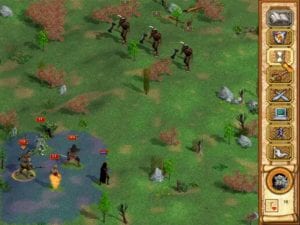
This one… well. It was controversial at the time. Very much so. Heroes 4 follows the plot of Heroes 3, where things finally come to a head and the two swords, Armageddon’s Blade and Sword of Frost clash… which prompts a cataclysm. Whoops.
As the entire world of Antagrich is destroyed, portals open to a new one, where many refugees from the dying planet end up.
But that’s the story. In terms of mechanics, Heroes 4 changed things up considerably. There’s six factions now – Haven, Perserve, Academy, Asylum, Necropolis and Stronghold. Each of them corresponds to a school of magic, respectively Life, Nature, Order, Chaos and Death. Then Stronghold is a Might faction, using no magic.
Moreover, heroes now take to the field as if they were units. In connection to that, they don’t need to be part of a stack. They can wander alone, and units can move without heroes. Needless to say, this is a major departure from the status quo.
Adding to that is a more elaborate skill system, with many skills allowing heroes to take a more hands-on approach. Heroes also gain new classes by combining different skills, with… mixed results. Training in combat skills also allows heroes to become hilariously lethal powerhouses, punching four dragons to death in one go.
As far as units go, a few things were different. They had more special powers and abilities, some of them even able to cast spells from a book, like heroes. Moreover, they can in four tiers, not seven. You had both of your town’s tier 1 units, but on the upper tiers, you had to pick. Building one dwelling locked out the other – though you could build it in another city if you wanted.
A severe overhaul to the mechanics aside, Heroes 4 lacked polish. It showed signs of a rush job, even in its graphics. Some units looked great; some were hideous. The mechanics were frequently janky; the battlefields weren’t as clear and easy to navigate as they used to be. Siege battles in particular were very poor. “Janky” generally describes the game; there’s many elements that just don’t seem to fit together entirely.
The expansions were somewhat unremarkable. They added new neutral creatures and campaigns. Which… I never played them much, but one of them involved a man by the name of Spazz Maticus. So I’m not sure what to think of them. It’s especially odd because the original campaigns have solid writing and characters. Gauldoth Half-Dead, in particular, serves as a solid example of a sympathetic necromancer.
I cannot condemn Heores 4 the way many others so. It has a lot going for it, even if it didn’t quite work in the end. Regardless, an era ended here and made way for a new one.
Heroes of Might and Magic 5
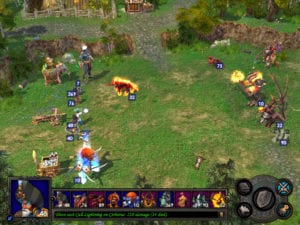
If Heroes 4 was controversial, this one wasn’t going to help. The series moved on to another publisher and development team and entirely abandoned all previous lore in favor of a new setting. It also moved into fully 3D graphics. To say that the players didn’t take to it well would be an understatement.
At the time, I hated it. Soooo much. It was an affront to everything Heroes stood for. Nowadays… I can see things more clearly. The graphical style remains goofy, but underneath is basically the Heroes 3 gameplay, with some refinements and possibly improvements. Heroes disappeared from the battlefield, but had their own initiative track and could attack enemies. That was unlike in Heroes 3 and before, where they could cast spells at any time during their units’ turns, but only once per a full round of initiative.
The graphics had their upsides and downsides. Some units looked good, some… well, gargoyles hit enemies with tablets and genies had hands larger than their heads, because they did not strictly speaking have the latter.
That being said, the new setting didn’t do the game any favors. Nor did the writing. The world is a generic fantasy setting, about as deep as a puddle and about as original as a coffee shop AU fanfiction. I won’t spend a lot of time talking about those.
What is worth noting is that Heroes 5 continued the trend towards a tighter aesthetic and deeper connection of setting/story and gameplay. The days of haphazard mix-and-match factions were over and they were more thematic now.
Which wasn’t so say they were radical departures from Heroes 3. Some towns followed their counterparts very closely. The Haven resembled the Castle. The Academy was even more similar to the Tower. The Inferno and Necropolis were more distinct from their Heroes 3 incarnations, but similarities remained. The two elven factions, Sylvan and Dungeon, were perhaps the most distant from the Rampart and Dungeon, but not entirely so.
The factions also had their unique skills, making them even more distinct. While in Heroes 4, magic skills were available to other factions, these were really specific. And… sometimes weird. The knights of Haven had the “Counterattack” skill, which let them retaliate to attacks against their units, but also let them train their human units into higher tiers.
Another example is the elven heroes’ ability to select favored enemies, which their units them strike more effectively against. But they can only pick one unit per level of the skill, and have to swap their picks in a city. Which means that the skill is at the mercy of happening to run into that one particular unit you’ve selected.
Other faction skills are better, to be fair. The Inferno’s Gating skill allows their heroes to summon extra units onto the field and feels like the best take on the concept. The Academy’s heroes can create mini-artifacts to enhance their units. The Dungeon’s warlocks can deal more damage with their units and spells by picking the right targets while the Necropolis’ Necromancers… well, they do what they do best.
Skills in general were more elaborate. They largely followed Heroes 3’s model, but apart from the basic tiers of skill proficiency, each of them had several secondary skills. Their availability was often dependent on factions and keyed off each other.
Heroes 5 saw two expansions. Hammers of Fate gives us the dwarven faction, which I found visually and thematically dull and never played much. Maybe I’m not fair to it. Their unique skill lets them cast special runic spells using resources, which was reportedly too strong at first.
The second expansion, Tribes of the East, is much more interesting. It introduces the orc faction, with the usual addition of goblins and cyclops, as well as some other creatures. Their special skill is Blood Rage, which lets them build up rage as the battle goes on, becoming stronger. Their heroes did not use spells – not even a little, like other Might Heroes did. They used warcries instead, which functioned in the same way but were unique to their faction.
Another major innovation were alternate upgrades. They resembled the tier choices of Heroes 4, but were not mutually exclusive. Once you upgraded a dwelling, you could recruit both versions. Unfortunately… the choices weren’t balanced. Many new upgrades were plain worse or better than the original ones.
Heroes 5 with Tribes of the East is a contender for the “ultimate” Heroes experience, along with Heroes 3. Not many would agree, I imagine, but to me it offers enough different ideas while retaining the core features of the series to stand shoulder to shoulder with Heroes 3. The setting is still paper-thin and the story is daft, but you can’t win ‘em all.
Might and Magic Heroes 6
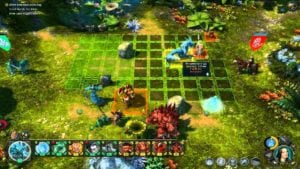
Or, as some would tell it, the beginning of the series’ final decline. I wouldn’t put it so harshly, but it’s hard to deny the game is missing something. I really tried and wanted to like it, but couldn’t. While I am inclined to side with innovation over tradition… there’s always the inherent risk that innovation won’t work. And here it did not.
The first change I noticed and didn’t particularly like was boiling down all the “rare” resources to one – sulfur, crystals, gems and mercury became just crystals. One could make an argument that each faction in the past games had one rare resource it relied on the most… but you still needed others. And you might not use only one faction.
Which, incidentally, is another sign of encouraging you to stick to your starting faction, which has been going on since at least Heroes 5. To the point where you can spend resources to convert cities you conquer to your faction.
Resource-gathering has changed in another way. Namely, instead of flagging every mine, we control entire areas. While we still need to capture resource mines in it, an enemy cannot steal them from us while we control the area. It does reduce the frustration of a low-level hero riding around with a handful of units and snatching them from us, but… doesn’t that lose some of the series’ spirit?
Another major change is that much like Heroes 4, Heroes 6 flattens unit tiers. Each faction has three common troops, three elite units and one champion unit. This alters the dynamic significantly.
Acquiring skills is no longer random. Heroes simply gain a point each level that they spend on skills, spells or warcries. Yes, spells are no longer randomly given out by mages’ guilds. And Might heroes gain their own category of active skills. I do like the latter part, but the whole change once again feels like taking something away.
There’s many other, more subtle changes. For instance, troop conservation is much easier. While we obviously always want to lose as few troops as we can, Heroes 6 makes it possible and desirable not to lose any units in many battles. Healing is much more potent, and can bring back dead units without the need for a separate resurrection effect. There is also more units that can heal, including low-tier ones like the vestals from Haven. Who, incidentally, die like fruit flies the moment an enemy chooses to attack them.
Faction skills are still around and fairly prominent. Of note is Necromancy, which no longer raises undead units. It heals them, instead, making the Necropolis faction shockingly durable. Once again, something’s lost. But on the other hand, the traditional Necromancy skill was always too powerful.
All of this adds up to an image that is still Heroes, but different. I feel that while I can appreciate those changes from a more theoretical perspective, they really tried to make Heroes into something it isn’t. That’s ever the risk with such innovations and Heroes 6 paid the price.
Might and Magic Heroes 7
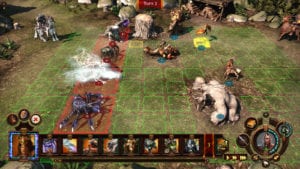
Here we come to the final chapter of the tale. I have not played it, but I followed the development. Some of the ideas looked interesting. They kept the flatter tiers of units, but brought back random skills. Unit abilities aren’t as elaborate as they used to be. It seems to be trying to bridge the developments of Heroes 6 with earlier games. A common preoccupation of developers after a previous game’s changes did not land.
Unfortunately, I never did get to play it, because by all accounts the game was a near-unplayable mess upon release. The multiplayer mode did not work at all. Patches were quick to follow, but we know how that goes. After one expansion, the development of the game folded quietly and nothing has followed.
Perhaps by now patches have rendered the game playable, so maybe I will try it someday. But, sadly, it looks like the series has ended with it. Another casualty of Ubisoft, or perhaps the blame doesn’t lie solely with them. But the old, venerable series is over, at least for the time being. Nonetheless, all the older games are still here. I hope I inspired you fine folk to try them out. They’re worth it, each and every one of them.
Images courtesy of UbiSoft

